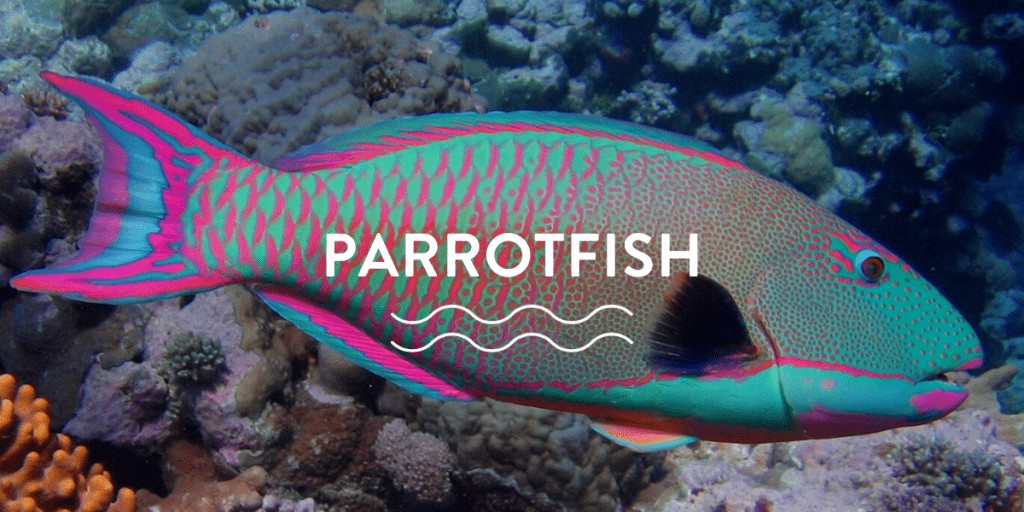Parrotfish live on coral reefs around the world. Even with their bright patterns, you can usually hear their grinding beak before you see them! Commonly found in the Atlantic, Pacific, and Indian oceans, with the highest species variety occurring in Indo-Pacific ocean regions. They’re named for their powerful beaks, which are formed from the fusing of their teeth into a biting plate, and their colourful patterns.
There are over 80 recognised species of parrotfish. We’re going to talk about our favourites later in this post…
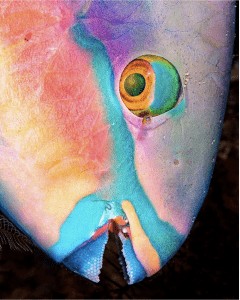
Ocean Mimic chose the Parrotfish to be one of the mimic suits because of their delightful fashion sense! They change their ‘outfits’ as they go through different life stages. Here’s what Emma had to say:
Parrotfish are such amazing colourful characters! No reef would be complete without their busy munching sounds and rainbow colours!

A few particulars about parrotfish:
Feeding
Parrotfish spend a shocking amount of time eating. Spending up to 90% of their day looking for food, nibbling on algae and dead coral. In other words, cleaning the reefs. They have a very important job in this respect because, sadly, most reefs in the Caribbean are being suffocated by algae. This stops them from performing photosynthesis and can lead to coral death. Through their constant grazing, parrotfish produce (or poop) up to 700 pounds (320 kilos) of sand each year!
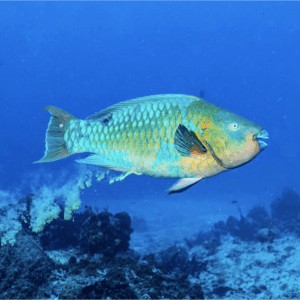
Reproduction
Their means of reproduction is just as interesting. Females will release eggs and males release sperm into the water column at the same time. This behavior is known as broadcast spawning. It’s a great strategy, as it increases the likelihood that eggs will become successfully fertilized and not eaten by predators. After the fertilised eggs are released in the water, they will begin hatching after around 25 hours.
Changing sexes
Just when you think these fish couldn’t get any more fascinating, they are smashing sexual norms and changing sexes! For example, all queen parrotfishes hatch as females, but as they mature the largest individuals become males. Ironically, the ‘crowns’ that give this species their queen common name are only found on males.
Mucus
One of the most unusual facts, and really cool things to see while night diving, is the ‘cocoon’. Parrotfish are known to find protected places to sleep at night and will surround itself with a cocoon-like structure of mucus. They create it to protect them from predators, as it tastes awful. Sneaky!
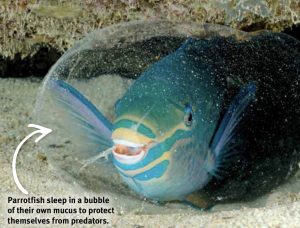
Some of our favourites.
Queen Parrotfish:
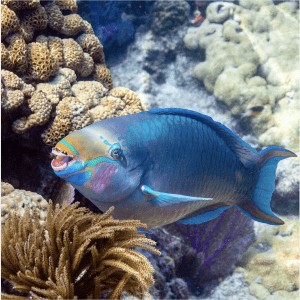
Mature queens are multi-colored in blue, green, orange, etc. and get their name from markings on its head that resemble a crown. They are a medium sized parrotfish, with an average size in length of 11-29 inches (30-75 cm).
Humphead Parrotfish:
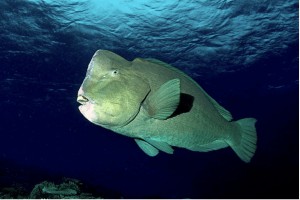
Often forming shoals 20 to 100 strong, they are a sight to see on a dive. The largest of the species, they can grow up to 1.5m long. A distinctive bump that grows on their heads as they mature is used to ram other males or to break off coral to eat.
Stoplight Parrotfish:
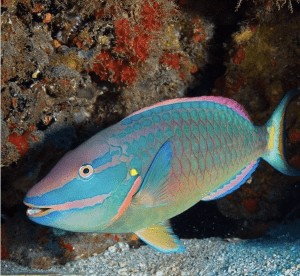
With 3 distinct life phases, they undergo dramatic colour changes while maturing. As harem forming fish, terminal males can defend areas housing 1-14 mates!
Read: 5 Creatures Vital to a Coral Reefs Survival where parrotfish feature.
So, what could possibly be threatening these gorgeous and vital fish?
You guessed it – Humans. We are their primary predators and we have long overfished them. Spearfishing is the most common method, but unfortunately this is almost too effective! The large and colourful males are being overfished. This impacts the sex ratio of the population, causing the dynamics to change and affecting the species ability to successfully reproduce.
Thankfully, they are listed as Least Concern on IUCN Red List, but, that being said, they are a vital part of the ecosystem and need to be protected. Many islands in the Caribbean eat them, which is concerning for the overall health of the ocean. Knowing what an important role this species plays in the health of coral reefs, some countries have taken action to help them. Specifically the island of Barbuda, where the local government has passed a law that completely protects parrotfish. It is now illegal to catch, buy, sell, or possess the fish. We can only hope that other island nations follow suit.
Next time you see a healthy reef or stroll down a fluffy white sand beach, thank a parrotfish!
Caitlin McCall is a PADI Scuba Instructor, Scientific Diver, and Science Communications Specialist. Find her on Instagram and Facebook: @SeaCaitlinMcCall & @EcoConsciousDiver. Listen to her podcast at www.eco-consciousdiver.com.


